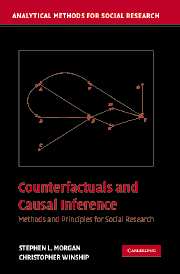Book contents
- Frontmatter
- Contents
- Acknowledgments
- Part 1 Counterfactual Causality and Empirical Research in the Social Sciences
- Part 2 Estimating Causal Effects by Conditioning
- Part 3 Estimating Causal Effects When Simple Conditioning Is Ineffective
- 6 Identification in the Absence of a Complete Model of Causal Exposure
- 7 Instrumental Variable Estimators of Causal Effects
- 8 Mechanisms and Causal Explanation
- 9 Repeated Observations and the Estimation of Causal Effects
- Part 4 Conclusions
- References
- Index
7 - Instrumental Variable Estimators of Causal Effects
Published online by Cambridge University Press: 05 June 2012
- Frontmatter
- Contents
- Acknowledgments
- Part 1 Counterfactual Causality and Empirical Research in the Social Sciences
- Part 2 Estimating Causal Effects by Conditioning
- Part 3 Estimating Causal Effects When Simple Conditioning Is Ineffective
- 6 Identification in the Absence of a Complete Model of Causal Exposure
- 7 Instrumental Variable Estimators of Causal Effects
- 8 Mechanisms and Causal Explanation
- 9 Repeated Observations and the Estimation of Causal Effects
- Part 4 Conclusions
- References
- Index
Summary
If a perfect stratification of the data cannot be achieved with available data, and thus neither matching nor regression nor any other type of basic conditioning technique can be used to effectively estimate a causal effect of D on Y, one solution is to find an exogenous source of variation that affects Y only by way of the causal variable D. The causal effect is then estimated by measuring how Y varies with the portion of the total variation in D that is attributable to the exogenous variation. The variable that indexes the portion of the total variation in D that is used to estimate the causal effect is an instrumental variable.
In this chapter, we orient the reader to IV estimation of causal effects by presenting examples of binary instruments, some of which are natural experiments because the IVs are “gifts of nature” (Rosenzweig and Wolpin 2000:872). We then return to the origins of IV techniques, and we contrast this estimation strategy with the perspective on regression that was presented in Chapter 5. We then develop the same ideas using the potential outcome framework, showing how the counterfactual perspective has led to a new literature on how to interpret IV estimates. This new literature suggests that IV techniques are more effective for estimating narrowly defined causal effects than for estimating the average causal effects that they are often mistakenly thought to inform.
- Type
- Chapter
- Information
- Counterfactuals and Causal InferenceMethods and Principles for Social Research, pp. 187 - 218Publisher: Cambridge University PressPrint publication year: 2007

